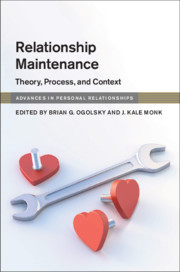Book contents
- Relationship Maintenance
- Advances in Personal Relationships
- Relationship Maintenance
- Copyright page
- Contents
- Tables
- Figures
- Contributors
- Part I Introduction
- Part II Theories of Relationship Maintenance
- Part III Processes of Relationship Maintenance
- Part IV The Social Context of Relationship Maintenance
- 14 Gender and Race Perspectives on Relationship Maintenance
- 15 Relationship Maintenance across Cultural Groups
- 16 Relationship Maintenance in the Age of Technology
- 17 Relationship Maintenance across the Life Course
- 18 Relationship Maintenance in Couple Therapy and Relationship Education
- Part V Conclusion
- Index
- References
14 - Gender and Race Perspectives on Relationship Maintenance
from Part IV - The Social Context of Relationship Maintenance
Published online by Cambridge University Press: 02 December 2019
- Relationship Maintenance
- Advances in Personal Relationships
- Relationship Maintenance
- Copyright page
- Contents
- Tables
- Figures
- Contributors
- Part I Introduction
- Part II Theories of Relationship Maintenance
- Part III Processes of Relationship Maintenance
- Part IV The Social Context of Relationship Maintenance
- 14 Gender and Race Perspectives on Relationship Maintenance
- 15 Relationship Maintenance across Cultural Groups
- 16 Relationship Maintenance in the Age of Technology
- 17 Relationship Maintenance across the Life Course
- 18 Relationship Maintenance in Couple Therapy and Relationship Education
- Part V Conclusion
- Index
- References
Summary
An underlying assumption across definitions of relationship maintenance is that these strategies, which are used to maintain a satisfactory state in the relationship, are uniform both within and across couples. However, couples or even partners within the same relationship may differ in how they define a satisfactory state based on their own characteristics and experiences. The goal of this chapter is to consider this diversity, not only in how couples maintain the relationship but also in how these maintenance strategies influence the quality of the relationship. Gender and race are the primary focus of this chapter, as both have been implicated as particularly salient contexts for relationship maintenance. Drawing when possible upon a dyadic approach to understand relationship maintenance, this chapter emphasizes the primary romantic relationship contexts in which gender and race are manifested (i.e., heterosexual and same-sex couples; intraracial and interracial couples) and the key correlates of maintenance within these relationships. Despite numerous advances made in this area over the past decade, more research is needed to explore the intersections of sex/gender and sexual orientation with race to understand how sensitive maintenance may be to the various individual, relational, and cultural contexts in which it occurs.
Keywords
- Type
- Chapter
- Information
- Relationship MaintenanceTheory, Process, and Context, pp. 265 - 283Publisher: Cambridge University PressPrint publication year: 2019



